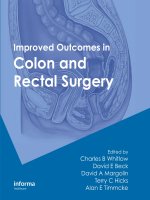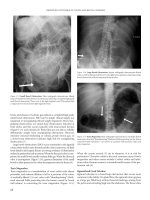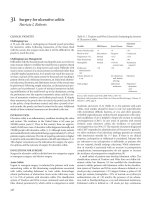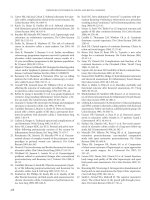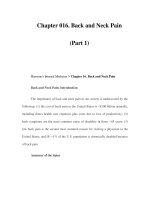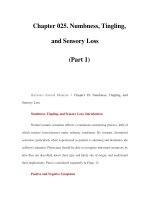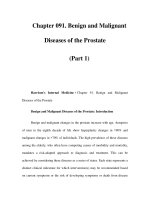Extreme Prematurity - Practices, Bioethics, And The Law Part 1 ppsx
Bạn đang xem bản rút gọn của tài liệu. Xem và tải ngay bản đầy đủ của tài liệu tại đây (151.24 KB, 25 trang )
This page intentionally left blank
P1: JZZ
0521862213pre CUFX052/Miller 0 521 86221 3 printer:cupusbw August 21, 2006 13:20
EXTREME PREMATURITY
Extreme Prematurity: Practices, Bioethics, and the Law examines the
controversial issues surrounding the clinical management of this
group of neonates through the intervention of modern neonatal
intensive care. The forgoing of life-sustaining treatment is of par-
ticular importance. The subject matter is very relevant because of
the alarming increase in multiple and preterm births, caused by the
increase in women undergoing assisted reproductive procedures,
and the large increase in premature labor. No recent book covers
the subject in such comparable breadth.
The first section of this very timely monograph covers the epi-
demiology and practices in different parts of the world; the second
section coversbioethics considerations, includingethical theories,
moral principles, and quality-of-life issues; the third section covers
national and international guidelines; and the last section covers
medical law aspects in the United States and around the world.
Geoffrey Miller is Professor of Pediatrics and Neurology at Yale
University School of Medicine.
i
P1: JZZ
0521862213pre CUFX052/Miller 0 521 86221 3 printer:cupusbw August 21, 2006 13:20
ii
P1: JZZ
0521862213pre CUFX052/Miller 0 521 86221 3 printer:cupusbw August 21, 2006 13:20
EXTREME PREMATURITY
Practices, Bioethics, and the Law
GEOFFREY MILLER
Yale University School of Medicine
iii
cambridge university press
Cambridge, New York, Melbourne, Madrid, Cape Town, Singapore, São Paulo
Cambridge University Press
The Edinburgh Building, Cambridge cb2 2ru, UK
First published in print format
isbn-13 978-0-521-86221-9
isbn-13 978-0-521-68053-0
isbn-13 978-0-511-24961-7
© Geoffrey Miller 2007
2006
Informationonthistitle:www.cambrid
g
e.or
g
/9780521862219
This publication is in copyright. Subject to statutory exception and to the provision of
relevant collective licensing agreements, no reproduction of any part may take place
without the written permission of Cambridge University Press.
isbn-10 0-511-24961-6
isbn-10 0-521-86221-3
isbn-10 0-521-68053-0
Cambridge University Press has no responsibility for the persistence or accuracy of urls
for external or third-party internet websites referred to in this publication, and does not
guarantee that any content on such websites is, or will remain, accurate or appropriate.
Published in the United States of America by Cambridge University Press, New York
www.cambridge.org
hardback
p
a
p
erback
p
a
p
erback
eBook (EBL)
eBook (EBL)
hardback
P1: JZZ
0521862213pre CUFX052/Miller 0 521 86221 3 printer:cupusbw August 21, 2006 13:20
FOR TRICIA
v
P1: JZZ
0521862213pre CUFX052/Miller 0 521 86221 3 printer:cupusbw August 21, 2006 13:20
vi
P1: JZZ
0521862213pre CUFX052/Miller 0 521 86221 3 printer:cupusbw August 21, 2006 13:20
C ONTENTS
Part 1: THE EXTREMELY PRETERM INFANT:
EPIDEMIOLOGY, PERCEPTIONS, AND PRACTICES
1 Introduction page 3
2 Historical Aspects 9
3 Survival 11
4 Influence of Obstetric Management 16
5 Effect of Resuscitation in the Delivery Room 18
6 National Comparisons 20
7 Prediction of Outcome 23
8 Limit of Viability 24
9 Morbidity 25
10 School Age Outcome 29
11 Adolescence 32
12 Perceptions and Practices 34
13 Resource Expenditure 45
Part 2: BIOETHICS
14 Moral Theory 51
15 Autonomy 59
16 Beneficence and Nonmaleficence 62
vii
P1: JZZ
0521862213pre CUFX052/Miller 0 521 86221 3 printer:cupusbw August 21, 2006 13:20
C ONTENTS
17 Justice 68
18 Sanctity of Life 70
19 Active and Passive Euthanasia 72
20 Personhood 74
21 Quality of Life and Best Interests 80
22 Futility 86
Part 3: REPORTS, OFFICIAL OPINIONS, AND
GUIDELINES
23 United States 91
24 Canada 106
25 United Kingdom (UK) 110
26 France 116
27 Italy 121
28 Germany 122
29 International 123
Part 4: THE LAW
30 Introduction 135
31 U.S. Law 138
32 The United Kingdom 160
33 Canada 168
34 Australia 173
35 Japan 176
36 Italy, Germany, and Poland 177
37 France 179
38 The Netherlands 181
Part 5: EPILOGUE: TRUTH, TRUST, AND
BOUNDARIES
Epilogue: Truth, Trust, and Boundaries 187
References 197
Index 221
viii
P1: KNR
0521862213sec1 CUFX052/Miller 0 521 86221 3 printer:cupusbw August 21, 2006 13:27
PART 1
THEEXTREMELY PRETERM INFANT
Epidemiology, Perceptions, and Practices
1
P1: KNR
0521862213sec1 CUFX052/Miller 0 521 86221 3 printer:cupusbw August 21, 2006 13:27
2
P1: KNR
0521862213sec1 CUFX052/Miller 0 521 86221 3 printer:cupusbw August 21, 2006 13:27
1
INTRODUCTION
T
hree-year-old D is a vivacious small child who smiles and
giggles freely. Her abdomen is criss-crossed with scars, the
result of neonatal surgery for necrotizing enterocolitis for which
she had surgical resection of some of her bowel. This was fol-
lowed by the fashioning of an ileostomy that was closed at two
years of age. There is also a scar over her left axilla, which fol-
lowed a thoracotomy and the closing of a patent ductus arte-
riosus that had caused heart failure during the early neonatal
period. She is the elder of twins, born at an uncertain gestation of
25 weeks weighing 810gs. Both babies were resuscitated at birth,
but one twin died on day of life 4. Baby D received prolonged
ventilation, required tracheostomy, and was discharged home on
a ventilator after many months in the hospital. The daily nursing
assistance the family received in their apartment was discontin-
ued following the weaning of ventilation when the baby was aged
15 months. Her early years are remarkable for frequent visits to dif-
ferent specialistsin the hospital who have monitored and managed
her neurological development, pulmonary status, eyes, and gas-
trointestinal function. Her family, who have limited economic
3
P1: KNR
0521862213sec1 CUFX052/Miller 0 521 86221 3 printer:cupusbw August 21, 2006 13:27
THEEXTREMELY PRETERM INFANT
resources, have undergone the most challenging of economic and
emotional strains, and although they have faced the challenges
most often with determined stoicism and love, there has often
been anguish. However, D has conducted her only known life
with the full gamut of emotional sparkle and oppositional irrita-
tion that would be expected from any able-bodied child. She has
done this without the use of speech–aconsequence of her tra-
cheostomy and her profound deafness, the latter perhaps related to
either her prematurity or aminoglycosides she received during the
neonatal period. She is now a candidate for a cochlear implant, an
option that would not have been available only a short time ago.
She has started to use consistent sign to communicate, and her
nonverbal developmental quotient is within the normal range.
Five-year-old B was born at 24 weeks’ gestation, weighing
580gs. At birth she did not breathe spontaneously, had a gelati-
nous feel to her skin, and could be held in the hand like a pound
of butter. She was resuscitated and ventilated without much diffi-
culty, and required about two weeks of intermittent positive pres-
sure ventilation followed by a period of continuous positive airway
pressure ventilation. She developed a grade II intraventricular
hemorrhage, and following weaning from the ventilator there were
many episodes of apnea and bradycardia, which responded to tac-
tile stimulation. After 10 weeks in the hospital, she was bottle-
feeding well and was discharged home one week later on an apnea
monitor. During her early months, she was often an irritable baby
who required frequent feeding, which was followed by episodes
of regurgitation. The consequence of this gastroesophageal reflux
was failure to thrive and choking episodes. The reflux failed to
respond to medical treatment and after an admission to the hos-
pital, because of severe aspiration pneumonia, she underwent a
gastric fundoplication. Her irritability improved and she began to
thrive. However, her development was relatively slow. She walked
4
P1: KNR
0521862213sec1 CUFX052/Miller 0 521 86221 3 printer:cupusbw August 21, 2006 13:27
INTRODUCTION
independently at 19 months and started to use two-word phrases
at about three years of age. Her single-parent mother, who was
aged 17 years at the birth of the baby, is now concerned and chal-
lenged because B demonstrates a reduced attention span, poor
frustration tolerance, impulsivity, and emotional lability. These
neurobehavioral difficulties have had an impact on her school-
ing, where she has difficulty staying in her seat, and with social
interaction. Despite this, she is often a loving, affectionate child,
with considerable charm. Psychometric evaluation was hampered
by variable attention, but a minimum IQ level was measured at
86. There were some findings that suggested she may be at risk
of demonstrating a specific learning disability, such as dyslexia,
in elementary school. Despite her present difficulties, for which
there are successful management strategies, and her extreme pre-
maturity, she is expected to become an independent adult whose
life will be governed by similar influences and fates that mould the
outcome of any individual who was born normal at term.
Jisafour-year-old boy who has recently started to walk using a
walker. He is small, with relative undergrowth of the lower half of
his body. He has a scaphocephalic head on which are perched thick
glasses, and below these is an infectious open-mouthed grin, which
is occasionally disfigured by a small amount of drooling. This, when
he is reminded, is wiped away by an incoordinated splayed hand.
He loves to demonstrate his walking ability and can hurtle down
a corridor, albeit in an ungainly fashion, with hips and knees bent
and knees knocking and on his toes. This is accompanied by much
mirth shared by J and his onlookers. He is adored by his parents
and two older sisters, and he adores them. J was born at 24 weeks,
weighing 610gs. He required several weeks of artificial ventilation
and developed a grade III intraventricular hemorrhage and pro-
nounced periventricular leukomalacia. He required gastrostomy
feeding for the first two years of his life, and he has had surgery
5
P1: KNR
0521862213sec1 CUFX052/Miller 0 521 86221 3 printer:cupusbw August 21, 2006 13:27
THEEXTREMELY PRETERM INFANT
for retinopathy of prematurity and for a strabismus. His cerebral
palsy and poor development was apparent during the first year
of life, and repeated cognitive assessments place him in the mild
mental retardation range with non–gross motor developmental
quotients ranging from 60 to 70. He is expected to achieve adult-
hood and live a life that, although requiring some assistance and
protection by others, will be one in which he is competent in
the activities of daily living and able to benefit from some basic
education and training.
Tisaged five years. He was born at 25 weeks’ gestation, weigh-
ing 700gs. Resuscitation was achieved easily after birth, and he was
ventilated with relative ease for about three weeks. On day of life 5,
he had developed a grade IV intraventricular hemorrhage, which
was accompanied by severe periventricular leukomalacia. By one
month of life, he was breathing independently but was unable to
feed and would later require a gastrostomy. It was soon clear that
he would develop substantial neurological handicap. Severe spas-
tic quadriparesis, anarthria, pseudobulbar palsy, microcephaly, and
what appears to be severe mental retardation now confine him
to a wheelchair. He is unable to feed himself and continues to
be fed by gastrostomy. He is incontinent and cannot indicate his
needs. However, he appears to respond to familiar voices and smile
socially and laughs with his siblings. Successful voluntary move-
ments are not possible, and any stimulus or attempt at movement
invokes mass, uncoordinated, stereotypic postures. There are con-
tractures in his arms and legs that hamper dressing, toileting, and
hygiene.
These cameos are very familiar to anyone involved in neona-
tal care and follow-up. They represent some of the complications
of prematurity, which vary in their severity and cause considerable
individual, social, and economic burden. Although it is the
6
P1: KNR
0521862213sec1 CUFX052/Miller 0 521 86221 3 printer:cupusbw August 21, 2006 13:27
INTRODUCTION
severely disabled child that may be most readily remembered, this
outcome is not the rule. However, all adverse outcomes become
more likely as birth weight and gestation decrease. Survival rates
for low birth weight and preterm infants are giving rise, it appears,
to an increasing prevalence of childhood neurodevelopmental dis-
ability, including severe forms of cerebral palsy. This has raised
bioethical and legal questions concerning this population of chil-
dren. These include topical and debatable concepts such as the
limits of viability, end of life decisions for those without capacity,
futility, parental and physician autonomy, distributive justice, the
role of statutory and case law, and so on.
For the purposes of this book, I define the extremely preterm
infant (EPTI) as one who is born at less than 28 weeks’ gesta-
tion. I also include the extremely low birth weight (ELBW) infant
born weighing less than 1,000g. The two are not synonymous
as the latter may include infants who are small for gestational
age and more mature than the former. However, the literature
includes both groups, and for the purposes of argument I do the
same.
Extreme prematurity is uncommon, occurring in about 1% of
live births(1). However, the moral dilemmas that arise from inten-
sive care for EPTIs is a continuing cause for concern. Although,
for some attitudes are fixed, for many the situation is fluid. But the
question remains the same. How far should those go, who care for
children, to preserve life at the inevitable expense to some babies,
families, and society of disability, emotional trauma, and financial
cost? Furthermore, attempts to answer this question are clouded
by uncertainty arising from the limitations of early prognosis,
variable and changing results of management, and differing sub-
jective judgments from health professionals, parents, guardians,
and the creators and arbiters of the law. Attempts to resolve the
7
P1: KNR
0521862213sec1 CUFX052/Miller 0 521 86221 3 printer:cupusbw August 21, 2006 13:27
THEEXTREMELY PRETERM INFANT
conflict are sought from religion, bioethics and moral philosophy,
sociocultural acceptance of certain behaviors, and the law, both
civil and criminal. But before these can be considered, it is nec-
essary to briefly provide some history and then document the epi-
demiology of EPTIs, the perceptions of those involved in their
care, and the resources expended.
8
P1: KNR
0521862213sec1 CUFX052/Miller 0 521 86221 3 printer:cupusbw August 21, 2006 13:27
2
HISTORICAL ASPECTS
D
epending on cultural, religious, and socioeconomic circum-
stance, infanticide occurred throughout history.(2,3) Dur-
ing the classical period, infants deemed abnormal were left to
die in the open,(4) and infanticide was not unusual up until the
20th century.(5,6) But as medical expertise and technology have
become increasingly sophisticated, active measures are now taken
to keep alive such infants, and the degree of this endeavor has
mirrored changes in societal attitude. This is particularly evident
for the EPTI. However, the requirement that physicians should
not provide treatment that they believe will be of no benefit can
also be dated back to the classical era, and there may well be a pos-
itive obligation not to do so. Hippocrates wrote that: “[W]henever
therefore a man suffers from an ill which is too strong for the means
at the disposal of medicine he surely must not expect that it be
overcome by medicine,” and, he continued, for the physician to
provide treatment in such a situation was “allied to madness.”(7)
And Plato, in The Republic, advised that the physician
should:
9
P1: KNR
0521862213sec1 CUFX052/Miller 0 521 86221 3 printer:cupusbw August 21, 2006 13:27
THEEXTREMELY PRETERM INFANT
For those whose bodies were always in a state of inner
sickness he did not attempt to prescribe a regime to
make their life a prolonged misery medicine was not
intended for them and they should not be treated even if
they were richer than Midas.(8)
Out of this history has arisen a requirement to care for the
EPTI, but not to oblige a physician to provide treatment that is
perceived as not beneficial. However, because of differing beliefs,
perceptions, and interpretations, there may be a conflict between
the requirement and the obligation.
10
P1: KNR
0521862213sec1 CUFX052/Miller 0 521 86221 3 printer:cupusbw August 21, 2006 13:27
3
SURVIVAL
F
rom 1980 to 2000, the infant mortality rate in the United
States has been reduced from 12.6 to 6.9 per 1,000 live
births.(9,10) This has occurred with an approximately 17%
increase in preterm birth rates,(9,11) and reductions in mortal-
ity have been highest for those with the lowest birth weights.(9)
This has been mainly attributable to gains in technology as well as
improvements in medical practice.(12–15) ELBW infants account
for nearly half of total perinatal mortality, despite being only a very
small percentage of total live births.(16) Much of the improve-
ment in mortality has occurred in the very and extremely preterm
groups.(17,18) There can be considerable variation in the results
of studies reporting mortality for the EPTI. To some extent this
is governed by the conduct of the studies,(19,20) for example,
whether the figures reported include total births, live births, or
neonatal intensive care unit (NICU) admissions; whether the
numbers were small or based on geographic populations; and
whether there were consistent approaches to management. Clearly
this variability may introduce uncertainty and incomprehensibil-
ity into the counseling of parents. Furthermore, one can speculate
11
P1: KNR
0521862213sec1 CUFX052/Miller 0 521 86221 3 printer:cupusbw August 21, 2006 13:27
THEEXTREMELY PRETERM INFANT
whether it might encourage a paternalistic use of figures by physi-
cians, when counseling, allowing for a reflection of their biases.
One physician might aggressively resuscitate, whereas another
might not.(21,22) But most well-conducted studies quote similar
figures, or if there is variability, explanations can be found. More
recent improvements in survival are particularly notable for those
born at less than 26 weeks’ gestation. Reasons for this include the
use of surfactant and steroids and an increase in the provision of
artificial ventilation, as well as a change in attitudes.
In the United States, during the 1990s, survival for infants
born at 24 weeks’ gestation was reported as 33–57% and at 25
weeks was 60–75%.(21–29)Inthe NICHD Neonatal Network
Study, the findings were that babies born during 1994 to 1995
weighing 501–800g have a mortality rate of 43%, and 15% of
these were not artificially ventilated.(30) The reported survival
for those born at 23 weeks is 20–25%, with reports in some cen-
ters of 41–48%.(31) El-Metwally, Vohr, and Tucker determined
the survival rates of infants born at 22 to 25 weeks’ gestation
during the 1990s in Rhode Island.(21) The rate of fetal death
(stillborn) was 24%. Of those born alive, 46% survived to dis-
charge. Survival rates, including fetal death, at 22, 23, 24, and 25
weeks were 1.8%, 34%, 49%, and 76% respectively; and exclud-
ing fetal death, they were 4.6%, 46%, 59%, and 82% respectively.
In addition to gestational age, variables associated with increased
chances of survival were birth weight, female gender, and the use of
surfactant. These authors concluded that it was important, when
considering survival rates at the limits of viability, that interpre-
tation took account of whether all births or just live births were
analyzed. This was a retrospective study and there were circum-
stances where treatment decisions could affect outcome. For exam-
ple, if the infant had no heart rate at birth, resuscitation often was
not started, although, as the authors wrote: “[O]ccasionally chest
12
P1: KNR
0521862213sec1 CUFX052/Miller 0 521 86221 3 printer:cupusbw August 21, 2006 13:27
SURVIVAL
compressions were started and resuscitative medicines given if
the neonatologist thought the infant appeared more mature than
the estimated gestational age, or if requested by parents.” Thus it
appears that survival at 22 weeks’ gestation is extremely unusual,
although it does occur,(21,32) but it dramatically increases for
each week of gestation.
In a Canadian report of infants born weighing less than 500g,
between 1983 and 1994, 25% were not given intensive care and
all died.(33)In2001, Chan et al. reported survival rates for EPTIs
from 17 Canadian NICUs(34) born at less than 26 weeks’ ges-
tation from 1996 through 1997. These EPTIs were 4% of NICU
admissions, but accounted for 22% of deaths. Of the 949 EPTIs
delivered, 42% died in the delivery room. The percentage of those
admitted to the NICU increased from 20% at 22 weeks to 91% at
25 weeks. Survival rate after admission was 14% at 22 weeks (range
0–33%), 40% at 23 weeks (range 0–100%), 57% at 24 weeks
(range 0–87%), and 76% at 25 weeks (range 57–100%). The over-
all survival rate for all infants was 1% at 22 weeks, 17% at 23 weeks,
44% at 24 weeks, and 68% at 25 weeks. Of interest was the finding
that surviving lower gestational age infants had fewer low Apgar
scores, which, to the authors, suggested that resuscitation bias may
have existed. In another Canadian study, Effer and colleagues pub-
lished the survival rates of 860 live births born at 24 and 25 weeks’
gestation from 13 tertiary centers.(35)At24weeks, survival was
56%, and it was 68% at 25 weeks.
Figures from Japan show impressive improvement over time.
Japanese neonatal mortality rates have fallen from 27.4 to 2.3 per
1,000 live births between 1950 and 1993, and in 1991 the survival
of infants born less than 1,000g reached about 72%.(36,37) For
1,655 infants born with birth weights less than 600g between 1984
and 1993, studied by Oishi, Nishida, and Sasaki,(38), about 28%
survived to hospital discharge. Of those born less than 24 weeks,
13
P1: KNR
0521862213sec1 CUFX052/Miller 0 521 86221 3 printer:cupusbw August 21, 2006 13:27
THEEXTREMELY PRETERM INFANT
17% survived, and of those over 24 weeks about 36% survived. The
survival rate for those less than 600g increased, when surfactant
therapy became widely available, from 22% in 1988 to 33% in
1989. The majority of deaths (68%) were within the first week
of life, and only 10% died after the neonatal period. Improved
survival for the smallest and most immature EPTI was likely also
affected by the Japanese Eugenic Protection Act, which defines
the fetal viability limit as “minimal duration of gestation which
renders fetuses capable of extrauterine life.”(39) This was amended
to 22 completed weeks in 1991.
In Australia, survival rates for the EPTI are similar to those
found in recent reports from other developed countries.(31)In
a study from Melbourne,(40) Gultom and colleagues reported
changes over time in attitudes to treatment and survival for infants
born at 23 to 27 weeks’ gestation. The authors noted increases in
survival rates over time and more frequent active management of
labor for gestations, they stated, that were previously considered
as nonviable. Overall, 85% were treated intensively, but the pro-
portion rose from 74% in 1983–1985 to 91% in 1992–1994. In
1983–1990, 51% of live born infants born 23 to 27 weeks’ gesta-
tion died, and this decreased to 28% for those born from 1992 to
1996.(41) The authors’ conclusions were that improving survival
rates were not only because of treatment factors such as antenatal
steroids and exogenous surfactant, but also because of a willingness
to treat the EPTI intensively.
In the large United Kingdom (UK) and Ireland population-
based study, reported in 2000 by Wood and colleagues,(42) data
was derived from 4,004 births born between 20 and 25 weeks’
gestation. There were only 1,185 live births, of which about one-
third died in the delivery room, and a further 43% died in the
hospital. That is, the survival rate overall was only 27% for live
births and 39% for those admitted to intensive care. For this latter
14
P1: KNR
0521862213sec1 CUFX052/Miller 0 521 86221 3 printer:cupusbw August 21, 2006 13:27
SURVIVAL
group, intensive care was withdrawn from 55% who died in the
unit. Consistent criteria for this were not documented. In a 2002
report from Paris, France,(43)oninfants born between 24 and
28 weeks’ gestation, about one-third died before discharge. All
received resuscitation at birth. Survival was most affected by birth
weight, with 42% surviving below 700g and 83% above 900g.
15


